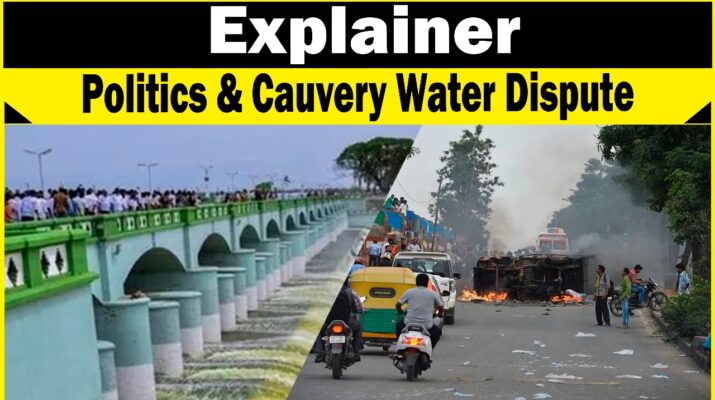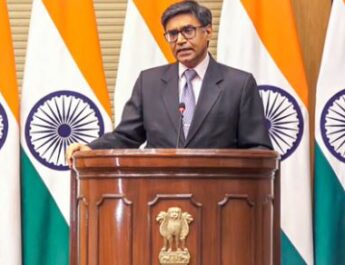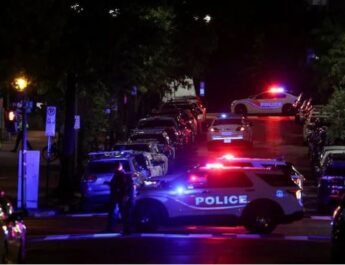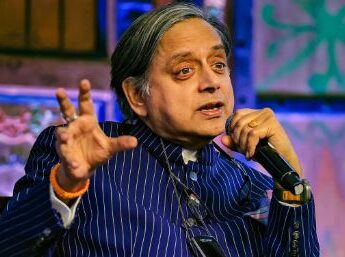What is the Cauvery water dispute? There is a Congress government in Karnataka and the Congress is also included in the alliance with the Stalin government in Tamil Nadu. Despite this, why is the water dispute between the two states not being resolved?
Kaveri is a river of South India. Quenching the thirst of the fields, flowing in the veins of the cities, and giving impetus to the industries, it flows through the two major states of Karnataka and Tamil Nadu. The fight over who will use how much water has been going on for 142 years.
Even on Friday i.e. 29th September, Karnataka remained closed in protest against the distribution of water from the Kaveri river. Bengaluru was closed 3 days before this on 26th September. In fact, the Cauvery Water Management Authority has asked the Karnataka government to provide 5,000 cusecs (cubic feet per second) of water to Tamil Nadu for 15 days. Which the people of Karnataka are opposing.
The dispute over the sharing of water of Kaveri river is 142 years old…
- In 1881, Mysore (now Karnataka) decided to build a dam on the Kaveri River. This decision was opposed by the Madras Presidency (now Tamil Nadu).
After this, an agreement was reached between the two in 1892 regarding the distribution of Kaveri water. Under the agreement, Karnataka was to get 177 thousand million cubic feet of water. Kerala was to get 5 thousand million cubic feet of water while Tamil Nadu and Puducherry were to get 556 thousand million cubic feet of water. - In 1881, the Princely State of Mysore and the Madras Presidency signed an agreement regarding the sharing of Kaveri waters. In 1924, an agreement was reached between the two to allot a fixed quantity of Kaveri water for 50 years.
- In 1956, three new states of Andhra Pradesh, Karnataka, and Kerala were formed. Because of this, once again it became necessary to amend the Cauvery Water Agreement.
- In the 60s, Karnataka proposed to build a new reservoir. The Center rejected the plan. Despite this, Karnataka built four reservoirs. The 1924 agreement ended in 1974.
After this, the Cauvery Fact Finding Committee was formed. Its final report came in 1976 and was accepted by all the states. However, when Karnataka started construction of Harangi Dam, Tamil Nadu moved to the Supreme Court. - Both states wanted to give less water to each other. Karnataka says that it lies first in the course of the river’s flow, hence it has the first right on the water. In such a situation, old agreements cannot be implemented between new states.
- Tamil Nadu said that Karnataka should follow the agreement made during the British era. He should continue to get as much water as he got earlier. Tamil Nadu needs more Kaveri water. Meanwhile, this dispute continued.
Riots against Tamil speakers in Karnataka over Cauvery water
It was the 90’s. The Central Government announced the formation of the ‘Cauvery Water Dispute Tribunal’ to resolve the Cauvery River water dispute. On June 25, 1991, this tribunal asked the Karnataka government to release 5.8 lakh crore liters of water to Tamil Nadu within a year.
Karnataka’s S Bangarappa government brought an ordinance in the Assembly against the tribunal’s decision, but the Supreme Court struck it down. After this, pro-Kannada organizations led by Vatal Nagaraj called for Karnataka bandh on 13 December, calling the decision of the Central Government biased.
The organization declared that Cauvery is the mother of Kannadigas, so we cannot give water to anyone else. The very next day, Kannada-speaking groups started targeting Tamil speakers in Bengaluru and Mysuru.
Tamil businessmen, movie theaters, and even vehicles with Tamil Nadu license plates were targeted. The entire colony of Tamils in Bengaluru was set on fire.
16 people died in police firing to control the crowd. This violence created fear among the Tamil-speaking people of southern Karnataka. Within a few weeks, thousands of Tamils were forced to flee. This incident created a situation of enmity between Karnataka and Tamil Nadu.
Kidnapping of Karnataka superstar Rajkumar and demand of Veerappan
It was July 2000. Kannada film star and first megastar of films, Dr. Rajkumar had come to Tirupati to have darshan of Lord Venkateswara. He was also accompanied by his wife Parvatamma, son-in-law AS Govindaraj, and assistant director Nagappa. On July 30, Dr. Rajkumar was returning to Karnataka after visiting.
Midway, he decided to stop at his palatial farmhouse in Gajnur, Tamil Nadu, before going to Karnataka. At 9:30 in the night, amidst heavy rain, nine armed men enter the prince’s house along with a thin man with a big mustache.
The man with the mustache says, ‘I am Veerappan, where are you, sir?’ There are five armed people standing outside the farmhouse. By then Veerappan had become quite notorious all over India. He was accused of killing more than 2000 elephants and 184 people.
After much negotiation, Veerappan released superstar Rajkumar after 108 days on 15 November 2000. During this time, Veerappan had placed two major demands before the Karnataka government to release the prince.
First – demanded the Karnataka government to adopt Tamil as an additional language in the state and to pay handsome compensation to those Tamil families who lost property and their people in the 1991 riots over the Cauvery water dispute. Second – an assurance that after Rajkumar’s release the Special Task Force will not launch a search operation for Veerappan. That means Veerappan also wanted to improve his image through the Cauvery water dispute.
The fight for Kaveri water started again in 2012…
After years of legal battles, the tribunal gave its final award in 2007. In this, 41.92% of water was allocated to the lower coastal state of Tamil Nadu, 27.36% to Karnataka, 12% to Kerala and 7.68% to Puducherry.
In 2012, Karnataka challenged the tribunal’s order in the Supreme Court due to drought. During this period, large-scale protests took place. Five JDS leaders in the Karnataka government resigned from their posts over the release of Cauvery water to Tamil Nadu.
In 2016, the Supreme Court ordered Karnataka to release 6,000 cusecs of Cauvery water to Tamil Nadu in 10 days. Protests started in Bengaluru after the decision. During this period two people lost their lives. Heavy police force was deployed in the Karnataka capital and more than 250 people were arrested for inciting violence.
In 2017, the Supreme Court reduced Tamil Nadu’s share of water to 177.25 thousand million cubic feet. After this, protests started in Tamil Nadu and many political parties demanded the formation of the Cauvery Water Management Board i.e. CWMB.
The Supreme Court in 2018 directed the Center to form a board to monitor Cauvery waters. Protests broke out in Tamil Nadu during Prime Minister Narendra Modi’s visit to Chennai in 2018. The protesters demanded their fair share in the Cauvery water.
In 2022, the Congress in Karnataka took out the ‘Mekedatu March’ demanding the construction of a reservoir on the Kaveri River at Mekedatu. In August of the same year, the Cauvery Water Management Authority (CWMA) announced the release of 10,000 cusecs of water to Tamil Nadu. Farmers and pro-Kannada organizations protested against this decision.
The situation worsened in September when farmers and pro-Kannada groups protested in Karnataka. This reignited the long-running Cauvery water dispute and brought it into the national spotlight.
On September 13 this year, the Cauvery Water Management Authority issued an order. It was said that Karnataka should give 5 thousand cusecs of water from the Kaveri river to Tamil Nadu for the next 15 days. The Supreme Court also upheld this decision on 21 September.
Farmer organizations of Karnataka, Kannada organizations, and opposition parties are opposing this decision. Due to this, more than 30 farmer organizations and Kannada organizations called Karnataka bandh on Friday. During this period, 44 flights to and from Bengaluru were canceled. Holidays were declared in many schools.
What can be the solution to the water dispute between Cauvery and Tamil Nadu?
Karnataka Deputy CM DK Shivakumar said in an interview that the only solution to this water dispute is the Mekedatu project of Ramanagara. Actually, this project involves the construction of a balancing reservoir near Kanakapura in the Ramnagar district. He says that last year more than 400 thousand metric cubic meters of water was wasted by flowing into the sea. If this water is reserved in the reservoir at Kanakapura through the Mekedatu project, the water dispute between the two states will be resolved.
Former PM HD Deve Gowda wrote a letter to PM Narendra Modi on September 25 saying that this dispute cannot be resolved without the intervention of the Prime Minister. The Center should file a petition in the Supreme Court demanding the formation of a 5-member expert panel. So that this panel gives suggestions regarding the proper distribution of water in the Kaveri River. He said that it is important for all the people in this panel to be independent. There is the least water in the Kaveri River in the last 100 years. In such a situation, water should be distributed as per present.
According to ORF researcher Ruchabh Rai, it is necessary to form an autonomous board approved by the Supreme Court so that impartial, credible, and timely recommendations can be implemented to resolve water disputes between states without political pressure, but without experts. Doing this through suggestions will not be enough.




